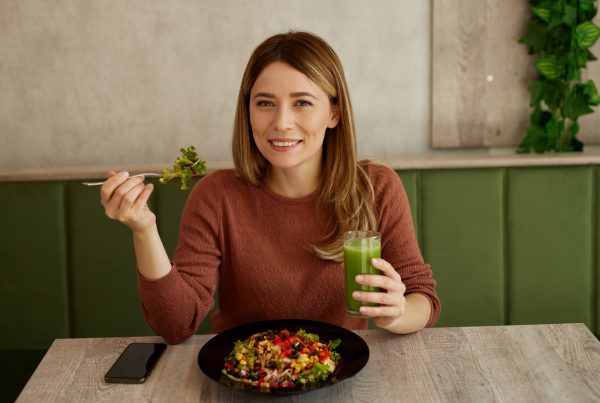We are told fish is good for us, yet it comes with many pollutants and contaminants. Add to that documentaries like Seaspiracy, which highlights the controversy of overfishing, and balancing it all out can seem like a challenge. Dr Linia Patel explores the pros and cons of consuming certain seafoods, so you can make informed decisions to benefit your health and the environment and know what truly are sustainable seafoods.
From a nutritional standpoint, seafood is an excellent, heart-healthy protein option. It is also high in B vitamins, selenium and vitamin D1. Eating fish, particularly oily fish, is considered the optimal food-based way to get adequate amounts of the essential fatty acids EPA and DHA. Studies show that consuming 250mg of these fatty acids each day (in two portions of fish per week) is associated with a 36% reduction in cardiac deaths from sudden cardiac arrest with or without pre-existing cardiovascular disease2. More specifically, omega-3s lower triglycerides, reduce risk of blood clots, lower blood pressure, reduce inflammation and decrease stroke. They have also been linked to a decreased risk of arthritis and Alzheimer’s disease and eyesight. A low intake of omega-3s increases your risk of poor vision (macular degeneration).1,2,3,4
The guidelines indicate that a healthy, balanced diet should include at least two portions of fish a week, including one portion of oily fish. Most of us in the UK aren’t eating this much. A portion is around 140g (4.9oz).2 According to the NHS, girls, women who are planning a pregnancy or may have a child one day, and pregnant and breastfeeding women should not eat more than two portions of oily fish a week. This is because pollutants found in oily fish may build in the body and affect the future development of a baby in the womb1,2,4.
Contaminated fish?
Numerous pollutants make their way into the foods we eat. Fish are no exception. The contaminants of most concern today are mercury, polychlorinated biphenyls (PCBs), dioxins and pesticide residues. Contaminants move up the food chain with bigger fish like shark, swordfish, salmon and tuna. Smaller fish like trout, mackerel, herring, pilchards, sardines and anchovies have fewer ocean contaminants.2
Very high levels of mercury can damage nerves in adults and disrupt development of the brain and nervous system in foetuses or young children. The effect of lower levels of mercury within the food chain are controversial. They have been linked to subtle changes in nervous system development and a possible increased risk of cardiovascular diseases. The case for PCBs and dioxins isn’t so clear.5,6
So, is avoiding fish the way to avoid pollutants and contaminants like mercury? Interestingly, a recent analysis looking at the potential risks for exposure to environmental toxins vs the overall benefits of consuming seafood overwhelmingly concluded that the benefits outweigh the risks5. The World Health Organization (WHO) also says that the health benefits gained from eating seafood – wild caught or farm raised – lends a health opportunity that outweighs the risk of not eating any seafood. That being said, it is recommended to make sustainable choices when possible.6
Wild vs farmed
Simply put, wild-caught seafood is obtained from a natural habitat (lake, ocean, river), whereas farmed seafood is raised by aquaculture. The nutritional quality of the seafood largely depends on what the fish eat and how much they move. Farmed fish live shorter lives, grow more quickly and move less. Fish in the wild eat a natural diet, move more and tend to be higher in omega-3 fatty acids and minerals, and lower in saturated fat, than farm-raised varieties7,8.
With regard to pollutants, mercury can be found in both farm-raised and wild-caught seafood due to industrial pollution that finds its ways into lakes, rivers and oceans. Some studies have shown that farm-raised fish tend to have a higher incidence of disease due to farming conditions, which then warrants the use of insecticides and the use of artificial dyes, which in turn affects the level of contamination in farmed fish7,8.
However, if we all ate wild salmon, the pressure on wild salmon would be tremendous. It would be unsustainable. At the heart of the controversy is that, when it comes to fish and seafood, we seem to have a limited palate. In fact, surveys suggest that 90% of the seafood we eat is linked to 10 species, prawns, shrimp, canned tuna, salmon, seabass, cod, crabs and clams being top of the list.
Know your fish1,2
|
Oily fish |
White fish | Shellfish |
| Oily fish are high in protein and rich in omega-3 fatty acids and vitamin D2.
|
White fish is high in protein and low in fat. Some varieties can be a source of omega-3 fatty acids, however at much lower levels than oily fish. | Shellfish is high in protein, low in fat and a rich source of selenium, zinc, iodine and copper. |
| Pilchards
Salmon Sardines Anchovies Mackerel Trout
|
Cod
Haddock Plaice Pollock Flounder Red mullet Seabass Tilapia |
Prawns
Scallops Mussels Squid Lobster Crab |
| Tip
Tinned varieties contain omega-3 too! Fresh and canned tuna DO NOT count as oily fish. |
Tip
Typically, white fish has lower levels of pollutants than oily fish; however, the following varieties of fish may have comparable amounts of pollutants to oily fish: seabream, sea bass, turbot and halibut. |
Tip Some types of shellfish, such as mussels, oysters, squid and crab, are also good sources of omega-3 fatty acids but they don’t contain as much as oily fish.
|
Sustainable fish
For seafood to be characterised as sustainable, it needs to be caught or farmed in a way that:
- minimises impact on fish stocks and the marine environment
- supports the livelihoods of fishing and coastal communities
- respects basic human rights, including welfare equality.
The Marine Stewardship Council (MSC) and the Marine Conservation Society are organisations that have developed certification programmes that show whether or not sustainable fishing practices have been met9.
Striking a balance for sustainable seafoods
It is possible to reap the health benefits of eating fish while minimising your intake of contaminants and supporting responsible fishing at the same time. Here is how:
- Choose a different variety of fish. Rather than going shopping with a specific fish in mind, take advantage of what’s fresh in the marketplace. Branch out and try a fish you haven’t eaten before. This helps build a market for abundant but under-utilised fish.
- Try to avoid eating endangered species or species that are not sustainable. These include Bluefin tuna, red snapper, Chilean seabass, Atlantic halibut and farmed king prawns9,10.
- Make smarter omega-3 choices. Smaller fish like sardines, pilchards, herring, trout and mackerel have a lower level of contaminants, so opt for these. Farmed blue mussels are also a great choice. They are also rich in omega-3 fats, magnesium and iron, and are a sustainable choice. They actually filter out water, which means they improve water quality!9,10,11
- Incorporate seaweed into your diet. Its rich in omega-3, high in trace minerals and there is a lot of it around.
- Become label savvy. Look at the location of capture, as this will also tell you whether it has been farmed. Keep an eye out for the sustainability logo from the Marine Stewardship Council or Marine Conservation Society.9
You should now go check out Linia’s best-selling online educations:
- Nutrition for Menopause
- Gut Health – the power of the microbiome
- Low Carb: the evidence & application
- Sports Nutrition Basics
Which one do you fancy?
AUTHOR BIO:

Dr Linia Patel has a BSc degree in biochemistry and physiology and has recently achieved a PhD in public health. Linia is a leading dietitian and sports nutritionist. Her passion is translating nutritional science into easy-to-digest and practical advice.
References
-
- Fish and shellfish – NHS (www.nhs.uk), accessed on 14 September 2021.
- Omega-3 Food Fact Sheet, British Dietetic Association (bda.uk.com), accessed on 14 September 2021.
- Yaghubi et al (2005), Dietary alpha-linolenic acid intake and risk of sudden cardiac death and coronary heart disease, Circulation, 112: 3,232-8.
- Raji C et al (2014), Regular fish consumption and age-related brain gray matter loss, Am J Prev Med., 47(4): 444-51.
- Mozaffarian D et al (2006), Fish intake, contaminants and human health: Evaluating the risk and the benefits, JAMA, 1,885-99.
- Joint FAO/WHO expert consultation on the risks and benefits of fish consumption (2010), Report of the Joint FAO/WHO Expert Consultation on the Risks and Benefits of Fish Consumption. rome, 25029 january 2010, accessed on 14 September 2021.
- Farmed fish. A healthy sustainable choice? https://www.eufic.org/en/food-production/article/farmed-fish-a-healthy-and-sustainable-choice, accessed on 14 September 2021.
- Jensen I et al (2020), An update on the content of fatty acids, dioxins, PCB’s and Heavy Metals in farmed, escaped and Wild Atlantic Salmon in Norway, Food, 9(12): 1,901.
- Sustainable seafood, Sustainability and responsible sourcing – Love Seafood, accessed on 14 September 2021.
- Environmental Defence Fund, https://seafood.edf.org/guide/worst, accessed on 14 September 2021
- Yaghubi E et al (2021), Farmed mussels: A nutritive protein source, rich in omega-3 fatty acids with a low environmental footprint, Nutrients, 13: 1,124.







